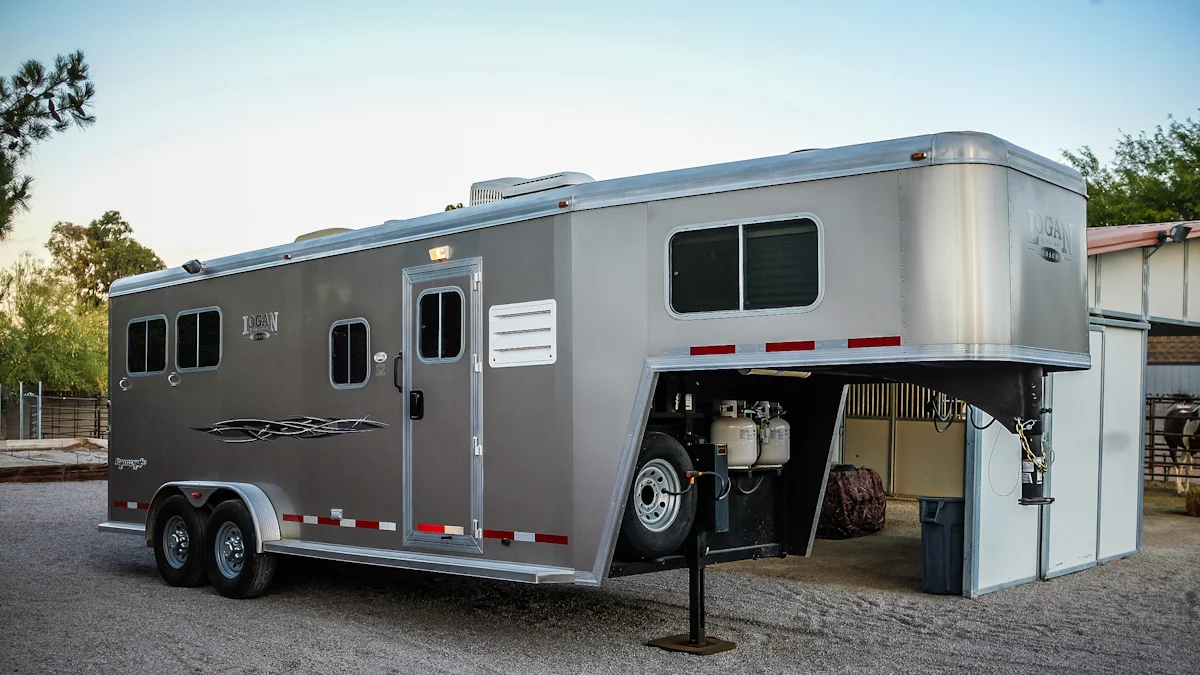
Understanding the Basics of Aluminum Horse Trailer Ramps
When it comes to building a horse trailer ramp, choosing the right material is crucial for ensuring durability and longevity. Aluminum is a popular choice for constructing ramps due to its lightweight nature and rust-resistant properties. This makes it an ideal material for withstanding the rigors of transporting horses and equipment.
Why Choose Aluminum?
Durability and Longevity
One of the primary reasons to choose aluminum for a horse trailer ramp is its exceptional durability. According to industry data from the Aluminum Association, aluminum alloy products with improved property combinations, such as specific weight percentages of zinc, magnesium, and copper, contribute to the overall strength and resilience of the material. This ensures that the ramp can withstand heavy loads and frequent usage without succumbing to wear and tear.
Weight Considerations
Another significant advantage of using aluminum is its lightweight nature. JIS specifications highlight that aluminum’s lightweight properties make it widely used in structures such as railway vehicles, ships, bridges, and various housings. When building a horse trailer ramp, utilizing aluminum allows for easier maneuverability while maintaining structural integrity.
Types of Aluminum Ramps
Factory-Built vs. Custom-Made
There are two main types of aluminum ramps: factory-built and custom-made. Custom loading ramps are designed specifically for the unique needs and elements of an operation, ensuring optimal efficiency, reliable performance, and enhanced safety during use. On the other hand, prefabricated mobile loading ramps may be suitable for most facilities but may not cater to specific requirements.
Planning Your Aluminum Horse Trailer Ramp
When planning the construction of an aluminum horse trailer ramp, it is essential to prioritize safety and efficiency. Designing the ramp with these factors in mind ensures a reliable and secure structure for loading and unloading horses and equipment.
Designing for Safety and Efficiency
Slip-Free Surfaces
One crucial aspect of designing an aluminum horse trailer ramp is incorporating slip-free surfaces. This feature is vital for ensuring that horses can confidently ascend and descend the ramp without the risk of slipping or losing their footing. To achieve this, consider utilizing specialized non-slip materials or adding texturing to the aluminum surface to enhance traction.
Appropriate Slope and Width
The slope and width of the ramp are key design considerations that directly impact its functionality. The slope should be gradual enough to facilitate comfortable movement for horses, preventing any abrupt changes in elevation that could cause distress or discomfort. Additionally, ensuring an adequate width allows ample space for horses to maneuver as they enter or exit the trailer, contributing to a smoother loading process.
Materials and Tools Needed
High-Strength Aluminum Selection
Selecting high-strength aluminum is fundamental to constructing a durable and resilient horse trailer ramp. The chosen aluminum material should possess exceptional tensile strength and corrosion resistance to withstand the demands of regular use while maintaining its structural integrity over time. Prioritize sourcing aluminum with proven durability properties to ensure longevity and reliability.
Essential Construction Tools
In addition to high-strength aluminum, several essential construction tools are necessary for building an aluminum horse trailer ramp effectively. These tools may include welding equipment, precision cutting tools, measuring instruments, fastening hardware, and protective gear. Utilizing appropriate tools not only facilitates precise construction but also contributes to the overall safety and quality of the finished ramp.
- Welding equipment
- Precision cutting tools
- Measuring instruments
- Fastening hardware
- Protective gear
Building the Ramp: Step-by-Step Guide

Once the design and material selection are finalized, it’s time to embark on the construction of the aluminum horse trailer ramp. This step-by-step guide will walk you through the process of creating a sturdy and reliable ramp for loading and unloading horses and equipment.
Constructing the Frame
Cutting and Welding the Aluminum Tubing
The first crucial step in constructing the ramp is to work on the frame, which provides structural support and stability. Begin by carefully measuring and cutting high-strength aluminum tubing to the required dimensions. Precision cutting tools such as saws or tube cutters can ensure accurate sizing, contributing to a seamless assembly process.
Welding plays a pivotal role in joining the aluminum tubing to form the frame. The patent titled “ALUMINUM ALLOY EXPANDED MATERIAL HAVING EXCELLENT WELDABILITY“ emphasizes the importance of utilizing aluminum alloy expanded material with excellent weldability, especially when subjected to high-speed welding techniques like laser welding. This ensures that weld cracks are minimized, enhancing the overall integrity of the frame structure.
Securing the Frame to the Trailer
Once the frame is constructed, it needs to be securely attached to the trailer for stability during usage. Fastening hardware such as bolts or brackets can be used to affix the frame to the trailer, ensuring a robust connection that can withstand dynamic loads when horses or equipment are being loaded onto or unloaded from the trailer.
Attaching the Ramp Surface
Choosing the Right Aluminum Sheet
Selecting an appropriate aluminum sheet for covering the ramp surface is essential for durability and longevity. The patent titled “SEMICONDUCTOR PROCESSING APPARATUS INCLUDING PLASMA-RESISTANT, WELDED ALUMINUM STRUCTURES” highlights methods of forming complex shapes using aluminum that can subsequently be anodized to provide plasma-resistant surfaces. Anodized aluminum coatings offer enhanced resistance against corrosive environments, contributing to improved performance over traditional welded articles exposed to harsh conditions.
Ensuring a Slip-Free Finish
To provide a safe environment for horses during loading and unloading, it’s imperative to ensure that aluminum horse trailer ramps have slip-free surfaces. Applying specialized non-slip coatings or incorporating texturing techniques on the aluminum sheet enhances traction, minimizing any risk of slippage for horses as they navigate across the ramp surface.
Maintenance and Safety Tips
Ensuring the ongoing safety and functionality of an aluminum horse trailer ramp involves regular inspection, maintenance, and adherence to safe usage practices. By implementing these essential measures, individuals can uphold the integrity of the ramp, mitigate potential hazards, and promote the well-being of horses during loading and unloading activities.
Regular Inspection and Upkeep
Checking for Wear and Tear
Regular inspection is paramount to identifying any signs of wear and tear that may compromise the structural integrity of the aluminum horse trailer ramp. This includes assessing components such as the aluminum frame, surface sheeting, fastening hardware, and non-slip coatings. Look for indications of corrosion, deformation, or damage that could affect the ramp’s stability or pose risks to horses during use.
Cleaning and Preventing Rust
To maintain the longevity of an aluminum horse trailer ramp, it is crucial to implement routine cleaning practices to prevent rust formation. Use mild detergents or specialized aluminum cleaners to remove dirt, debris, and contaminants from the surface. Additionally, consider applying protective coatings or sealants specifically designed for aluminum surfaces to inhibit rust development and enhance corrosion resistance.
Safe Usage Practices
Training Horses for Ramp Use
Properly training horses for navigating a aluminum horse trailer ramp is essential for their safety and comfort during loading and unloading procedures. Gradually introduce horses to the ramp environment through positive reinforcement techniques, encouraging them to walk on and off the ramp calmly. Consistent training fosters familiarity with the ramp structure and minimizes anxiety or reluctance when using it.
Loading and Unloading Equipment Safely
In addition to ensuring horses are comfortable with using the ramp, it is equally important to practice safe loading and unloading procedures for equipment. When transporting heavy machinery or gear on an aluminum horse trailer ramp, prioritize even weight distribution across the surface area. Utilize appropriate securing mechanisms such as tie-down straps or restraints to prevent shifting or movement during transit.
By adhering to these maintenance guidelines and safety practices, individuals can uphold a secure environment for both horses and equipment when utilizing an aluminum horse trailer ramp.
Wrapping Up
Recap of Key Points
As you conclude the journey of learning about building a safe and sturdy aluminum horse trailer ramp, it’s essential to recap the key points that have been highlighted throughout this comprehensive guide.
- Material Selection: The choice of aluminum for constructing horse trailer ramps offers exceptional durability, longevity, and lightweight properties, making it an ideal material for withstanding the demands of transporting horses and equipment.
- Design Considerations: Prioritizing safety and efficiency in the design process is crucial. Incorporating slip-free surfaces, appropriate slope and width, high-strength aluminum selection, and essential construction tools are fundamental aspects to consider when planning and building an aluminum horse trailer ramp.
- Construction Process: The step-by-step guide emphasizes the importance of constructing a sturdy frame through precise cutting and welding of high-strength aluminum tubing. Additionally, selecting the right aluminum sheet for the ramp surface and ensuring a slip-free finish are vital for creating a reliable loading platform.
- Maintenance and Safety: Regular inspection, upkeep, cleaning practices, rust prevention, safe usage practices, and proper training for horses contribute to maintaining the integrity and safety of an aluminum horse trailer ramp.
Encouragement for DIY Builders
For individuals considering embarking on the journey of building their own aluminum horse trailer ramp, it’s important to approach the project with enthusiasm and dedication. By embracing a do-it-yourself (DIY) mindset, you have the opportunity to create a customized ramp tailored to your specific needs while ensuring its quality and safety standards.
Embracing DIY projects fosters creativity, problem-solving skills, and a deeper understanding of construction principles. As you venture into this endeavor, remember that thorough research, attention to detail, patience during construction processes, adherence to safety guidelines, and continuous learning are key elements in achieving success.
Whether you’re an experienced builder or exploring construction projects for the first time, take pride in your craftsmanship as you contribute to creating a secure environment for transporting horses and equipment. Your commitment to excellence in craftsmanship will undoubtedly result in a functional and reliable aluminum horse trailer ramp that meets your unique requirements.
Embark on your DIY journey with confidence as you build a safe and sturdy aluminum horse trailer ramp that reflects your dedication to quality workmanship.









